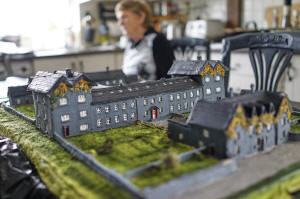‘Chamber of horrors’ being exhumed at Ireland mass baby grave
[July 31, 2025]
By BRIAN MELLEY
TUAM, Ireland (AP) — Only one stone wall remains of the old mother and
baby home in this town, but it has cast a shadow over all of Ireland.
A mass grave that could hold up to nearly 800 infants and young children
— some of it in a defunct septic tank — is being excavated on the
grounds of the former home run by the Bon Secours Sisters, an order of
nuns.
The burial site has forced Ireland and the Catholic Church — long
central to its identity — to reckon with a legacy of having shunned
unmarried mothers and separated them from their children left at the
mercy of a cruel system.
The grave was accidentally discovered by two boys a half century ago.
But the true horror of the place was not known until a local historian
began digging into the home’s history.
Catherine Corless revealed that the site was atop a septic tank and that
796 deceased infants were unaccounted for. Her findings caused a scandal
when the international news media wrote about her work in 2014.
When test excavations later confirmed an untold number of tiny skeletons
were in the sewage pit, then-Prime Minister Enda Kenny called it a
“chamber of horrors.”
Pope Francis later apologized for the church’s “crimes” that included
forced separations of unwed mothers and children. The nuns apologized
for not living up to their Christianity.
A cold, cramped and deadly place
The homes were not unique to Ireland and followed a Victorian-era
practice of institutionalizing the poor, troubled and neglected
children, and unmarried mothers.
The Tuam home was cold, crowded and deadly. Mothers worked there for up
to a year before being cast out — almost always without their children.

Corless’ report led to a government investigation that found 9,000
children, or 15%, died in mother and baby homes in the 20th century. The
Tuam home — open from 1925 to 1961 — had the highest death rate.
Corless said she was driven to expose the story “the more I realized how
those poor, unfortunate, vulnerable kids, through no fault of their own,
had to go through this life.”
Discovering deeply held secrets
Corless’ work brought together survivors of the homes and children who
discovered their own mothers had given birth to long-lost relatives who
died there.
Annette McKay said there’s still a level of denial about the abuse, rape
and incest that led some women to the homes while fathers were not held
accountable.
“They say things like the women were incarcerated and enslaved for being
pregnant,” McKay said. “Well, how did they get pregnant? Was it like an
immaculate conception?”
Her mother ended up in the home after being raped as a teenager by the
caretaker of the industrial school where she had been sentenced for
“delinquency” after her mother died and father, a British soldier,
abdicated responsibility.
Her mother, Margaret “Maggie” O’Connor, only revealed her secret when
she was in her 70s, sobbing hysterically when the story finally came
out.
[to top of second column]
|

Catherine Corless, who discovered that nearly 800 children died at a
mother and baby home in Tuam, Ireland, is seen with a replica she
built of the home Tuesday, July 8, 2025. (AP Photo/Brian Melley)

Six months after giving birth in Tuam in 1942, O’Connor was hanging
laundry at another home where she had been transferred when a nun
told her, “the child of your sin is dead.”
She never spoke of it again.
Some 20 years later, a Sunday newspaper headline about a “shock
discovery” in Tuam caught McKay’s attention. Among the names was her
long-lost sister, Mary Margaret O’Connor, who died in 1943.
Shame’s long shadow
Barbara Buckley was born in the Tuam home in 1957 and was 19 months
old when she was adopted by a family in Cork.
She was an adult when a cousin told her she’d been adopted and was
later able to find her birth mother through an agency.
Her mother came to visit from London for two days in 2000 and
happened to be there on her 43rd birthday, though she didn’t realize
it.
“I found it very hard to understand, how did she not know it was my
birthday?” Buckley said. “Delving deep into the thoughts of the
mothers, you know, they put it so far back. They weren’t dealing
with it anymore.”
She said her mother had worked in the laundry and was sent away
after a year, despite asking to stay longer. Her lasting memory of
the place was only being able to see the sky above the high walls.
At the end of their visit, her mother told her it had been lovely to
meet her and her family, but said she’d never see her again.
Buckley was devastated at the rejection and asked why.
“She said, ‘I don’t want anyone finding out about this,’” Buckley
said. “Going back to 1957 — and it was still a dark secret.”
Luck of the Irish
Pete Cochran considers himself one of the lucky ones.
He was 16 months old when he got out of the home and was adopted by
a family in the U.S., where he avoided the stigma that would have
dogged him as a so-called illegitimate child in his homeland.
During his visit to Tuam before the dig began, a man from town told
him at a bar: “I respect you now, but growing up, I used to spit on
you because that’s what I was taught.”
Cochran hopes the dig turns up few remains.
“I hope they don’t find 796 bodies,” he said. “That all these
children were adopted and had a good life like I did.”
McKay has had the same hope for her sister. But even if they found a
thimble full of her remains, she’d like to reunite her with her mom,
who died in 2016.
“The headstone hasn’t got my mother’s name on it because I fought
everybody to say I refuse to put my mom’s name on until she can have
her child with her,” McKay said.
All contents © copyright 2025 Associated Press. All rights reserved |